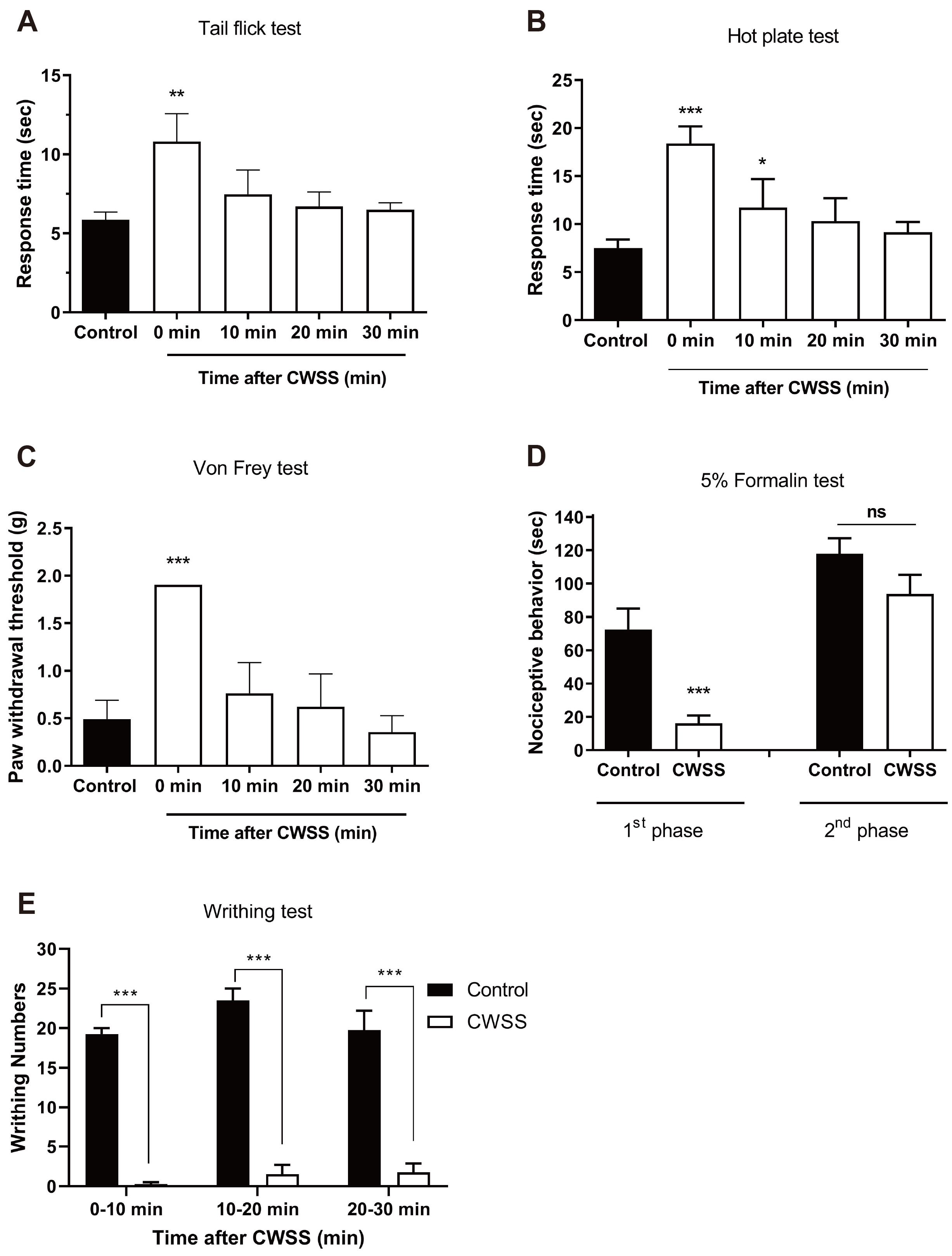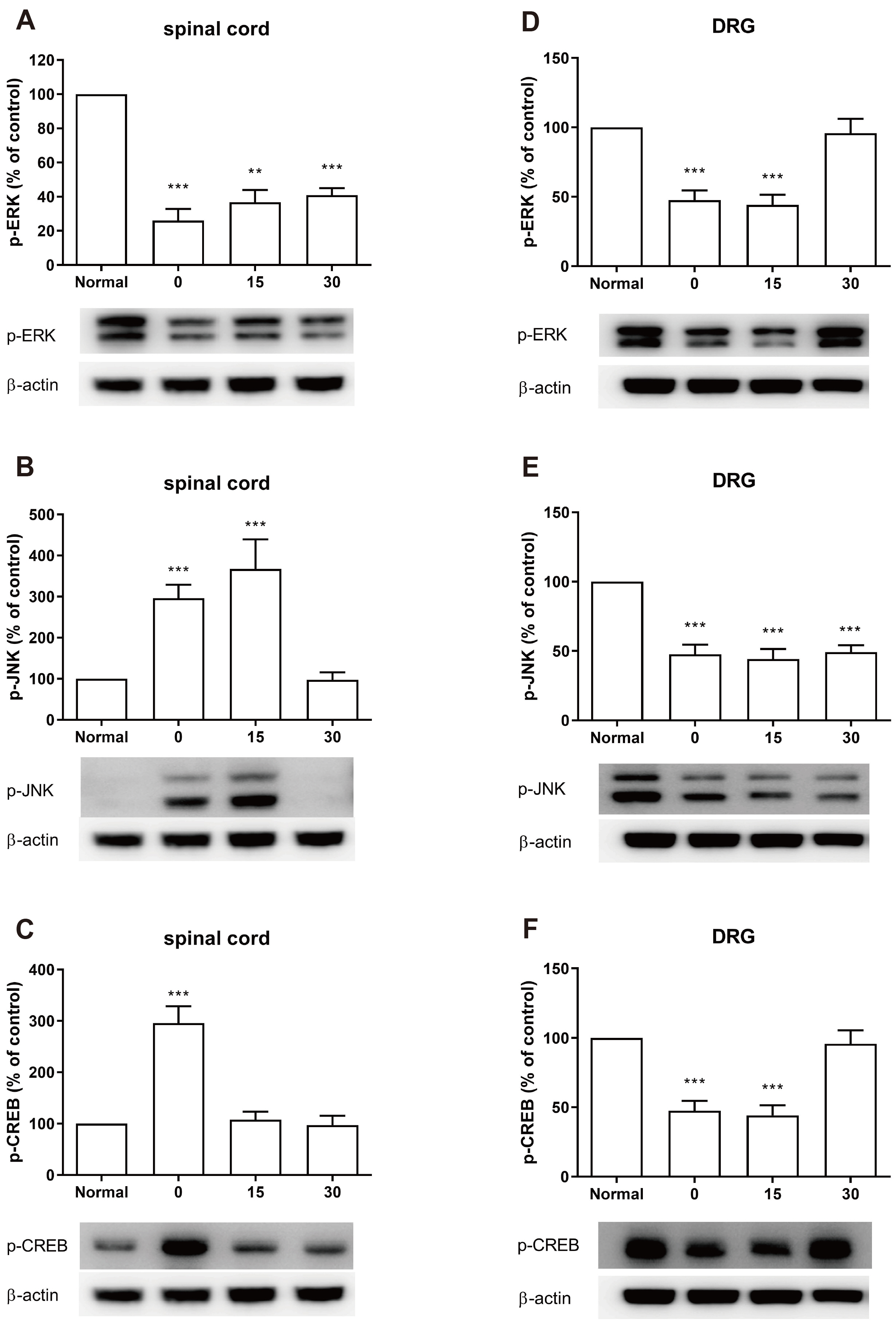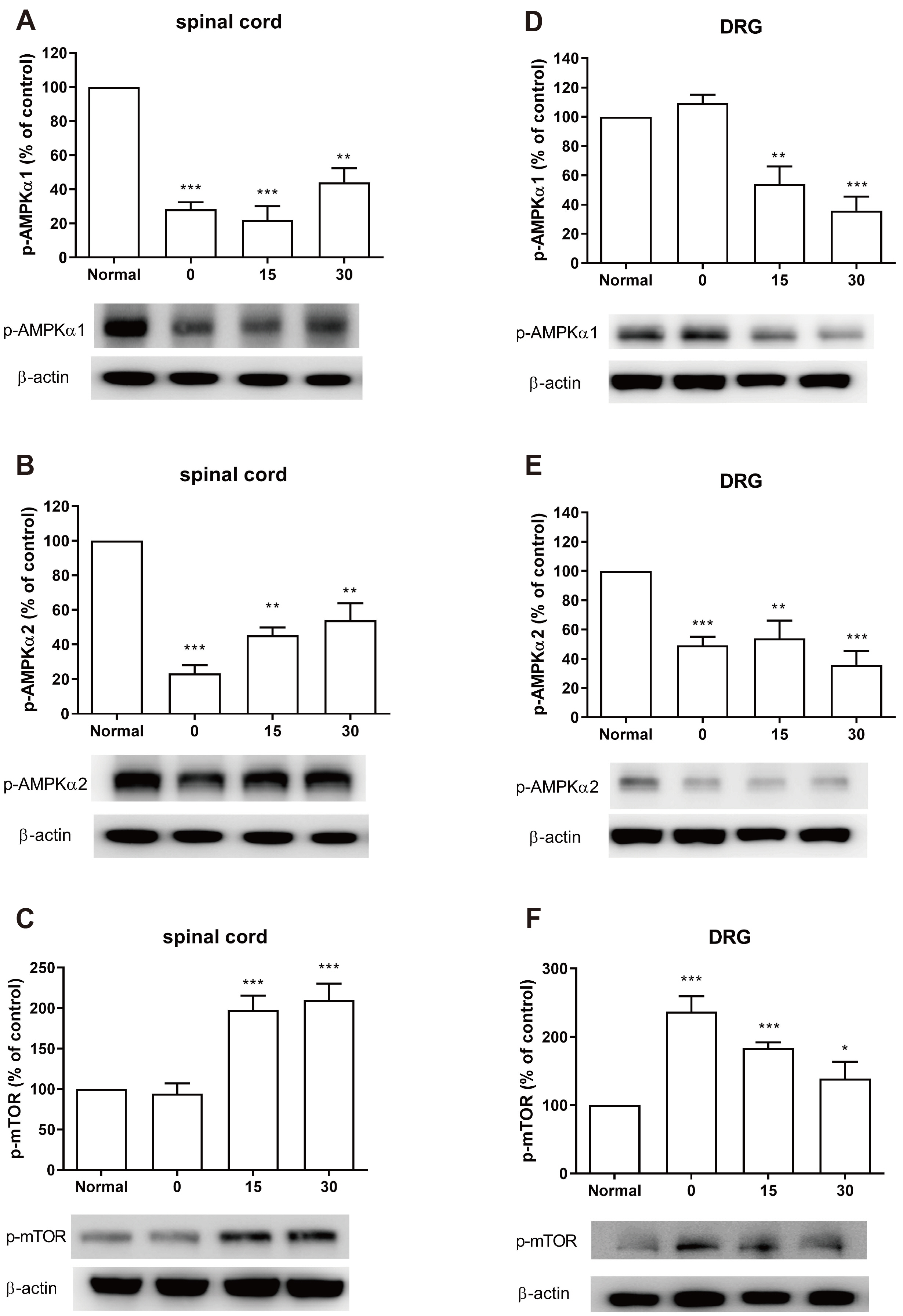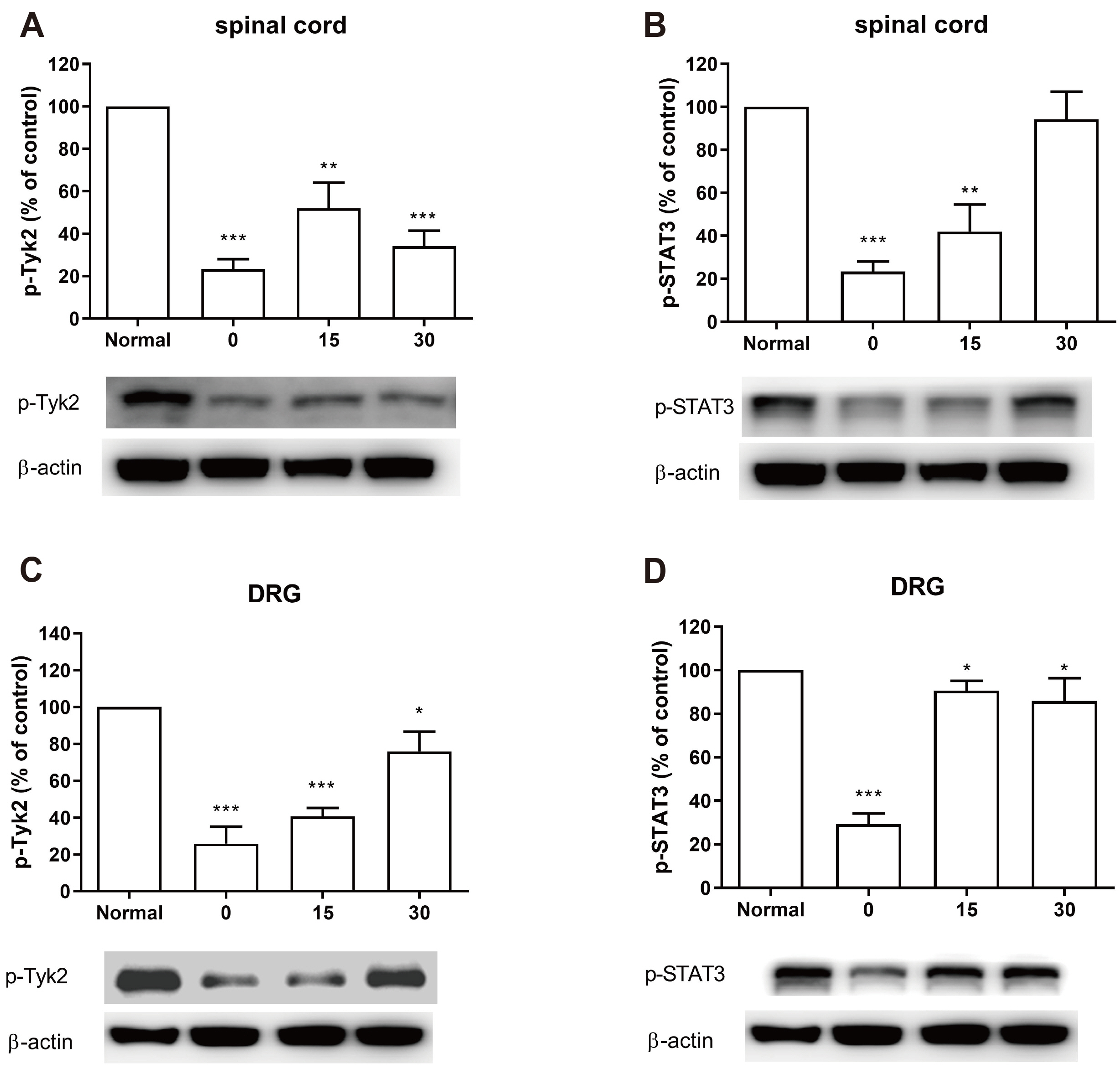Korean J Physiol Pharmacol.
2021 May;25(3):207-216. 10.4196/kjpp.2021.25.3.207.
The changes of nociception and the signal molecules expression in the dorsal root ganglia and the spinal cord after cold water swimming stress in mice
- Affiliations
-
- 1Department of Pharmacology and Institute of Natural Medicine, College of Medicine, Hallym University, Korea
- 2Department of Physical Education, Hallym University, Chuncheon 24252, Korea
- KMID: 2514946
- DOI: http://doi.org/10.4196/kjpp.2021.25.3.207
Abstract
- Several studies have previously reported that exposure to stress provokes behavioral changes, including antinociception, in rodents. In the present study, we studied the effect of acute cold-water (4°C) swimming stress (CWSS) on nociception and the possible changes in several signal molecules in male ICR mice. Here, we show that 3 min of CWSS was sufficient to produce antinociception in tailflick, hot-plate, von-Frey, writhing, and formalin-induced pain models. Significantly, CWSS strongly reduced nociceptive behavior in the first phase, but not in the second phase, of the formalin-induced pain model. We further examined some signal molecules' expressions in the dorsal root ganglia (DRG) and spinal cord to delineate the possible molecular mechanism involved in the antinociceptive effect under CWSS. CWSS reduced p-ERK, p-AMPKα1, p-AMPKα2, p-Tyk2, and p-STAT3 expression both in the spinal cord and DRG. However, the phosphorylation of mTOR was activated after CWSS in the spinal cord and DRG. Moreover, p-JNK and p-CREB activation were significantly increased by CWSS in the spinal cord, whereas CWSS alleviated JNK and CREB phosphorylation levels in DRG. Our results suggest that the antinociception induced by CWSS may be mediated by several molecules, such as ERK, JNK, CREB, AMPKα1, AMPKα2, mTOR, Tyk2, and STAT3 located in the spinal cord and DRG.
Keyword
Figure
Reference
-
1. Fazli-Tabaei S, Yahyavi SH, Nouri M, Zartab H, Javid G, Loghavi S, Zarrindast MR. 2006; Dopamine receptor mechanism(s) and antinociception and tolerance induced by swim stress in formalin test. Behav Pharmacol. 17:341–347. DOI: 10.1097/01.fbp.0000224383.63744.69. PMID: 16914952.
Article2. Oluyomi AO, Hart SL. 1990; Alpha-adrenoceptor involvement in swim stress-induced antinociception in the mouse. J Pharm Pharmacol. 42:778–784. DOI: 10.1111/j.2042-7158.1990.tb07020.x. PMID: 1982301.3. Romano JA, Shih TM. 1983; Cholinergic mechanisms of analgesia produced by physostigmine, morphine and cold water swimming. Neuropharmacology. 22:827–833. DOI: 10.1016/0028-3908(83)90127-2. PMID: 6621812.
Article4. Vaswani KK, Richard CW 3rd, Tejwani GA. 1988; Cold swim stress-induced changes in the levels of opioid peptides in the rat CNS and peripheral tissues. Pharmacol Biochem Behav. 29:163–168. DOI: 10.1016/0091-3057(88)90290-0. PMID: 3353422.
Article5. von Hehn CA, Baron R, Woolf CJ. 2012; Deconstructing the neuropathic pain phenotype to reveal neural mechanisms. Neuron. 73:638–652. DOI: 10.1016/j.neuron.2012.02.008. PMID: 22365541. PMCID: PMC3319438.
Article6. Costigan M, Scholz J, Woolf CJ. 2009; Neuropathic pain: a maladaptive response of the nervous system to damage. Annu Rev Neurosci. 32:1–32. DOI: 10.1146/annurev.neuro.051508.135531. PMID: 19400724. PMCID: PMC2768555.
Article7. Woolf CJ, Ma Q. 2007; Nociceptors--noxious stimulus detectors. Neuron. 55:353–364. DOI: 10.1016/j.neuron.2007.07.016. PMID: 17678850.
Article8. Dubin AE, Patapoutian A. 2010; Nociceptors: the sensors of the pain pathway. J Clin Invest. 120:3760–3772. DOI: 10.1172/JCI42843. PMID: 21041958. PMCID: PMC2964977.
Article9. Butler RK, Finn DP. 2009; Stress-induced analgesia. Prog Neurobiol. 88:184–202. DOI: 10.1016/j.pneurobio.2009.04.003. PMID: 19393288.
Article10. Li ZY, Huang Y, Yang YT, Zhang D, Zhao Y, Hong J, Liu J, Wu LJ, Zhang CH, Wu HG, Zhang J, Ma XP. 2017; Moxibustion eases chronic inflammatory visceral pain through regulating MEK, ERK and CREB in rats. World J Gastroenterol. 23:6220–6230. DOI: 10.3748/wjg.v23.i34.6220. PMID: 28974888. PMCID: PMC5603488.
Article11. Zhang T, Zhang N, Zhang R, Zhao W, Chen Y, Wang Z, Xu B, Zhang M, Shi X, Zhang Q, Guo Y, Xiao J, Chen D, Fang Q. 2018; Preemptive intrathecal administration of endomorphins relieves inflammatory pain in male mice via inhibition of p38 MAPK signaling and regulation of inflammatory cytokines. J Neuroinflammation. 15:320. DOI: 10.1186/s12974-018-1358-3. PMID: 30442166. PMCID: PMC6236886.
Article12. Zhou J, Lin W, Chen H, Fan Y, Yang C. 2016; TRESK contributes to pain threshold changes by mediating apoptosis via MAPK pathway in the spinal cord. Neuroscience. 339:622–633. DOI: 10.1016/j.neuroscience.2016.10.039. PMID: 27789381.
Article13. Ma W, Quirion R. 2005; The ERK/MAPK pathway, as a target for the treatment of neuropathic pain. Expert Opin Ther Targets. 9:699–713. DOI: 10.1517/14728222.9.4.699. PMID: 16083338.
Article14. Smith MT, Woodruff TM, Wyse BD, Muralidharan A, Walther T. 2013; A small molecule angiotensin II type 2 receptor (AT₂R) antagonist produces analgesia in a rat model of neuropathic pain by inhibition of p38 mitogen-activated protein kinase (MAPK) and p44/p42 MAPK activation in the dorsal root ganglia. Pain Med. 14:1557–1568. DOI: 10.1111/pme.12157. PMID: 23742186.15. Ge A, Wang S, Miao B, Yan M. 2018; Effects of metformin on the expression of AMPK and STAT3 in the spinal dorsal horn of rats with neuropathic pain. Mol Med Rep. 17:5229–5237. DOI: 10.3892/mmr.2018.8541. PMID: 29393487. PMCID: PMC5865989.
Article16. Liu Y, Li J, Li H, Shang Y, Guo Y, Li Z, Liu Z. 2019; AMP-activated protein kinase activation in dorsal root ganglion suppresses mTOR/p70S6K signaling and alleviates painful radiculopathies in lumbar disc herniation rat model. Spine (Phila Pa 1976). 44:E865–E872. DOI: 10.1097/BRS.0000000000003005. PMID: 30817738.
Article17. Zhang Y, Tao GJ, Hu L, Qu J, Han Y, Zhang G, Qian Y, Jiang CY, Liu WT. 2017; Lidocaine alleviates morphine tolerance via AMPK-SOCS3-dependent neuroinflammation suppression in the spinal cord. J Neuroinflammation. 14:211. DOI: 10.1186/s12974-017-0983-6. PMID: 29096659. PMCID: PMC5667445.
Article18. Izumi Y, Sasaki M, Hashimoto S, Sawa T, Amaya F. 2015; mTOR signaling controls VGLUT2 expression to maintain pain hypersensitivity after tissue injury. Neuroscience. 308:169–179. DOI: 10.1016/j.neuroscience.2015.09.013. PMID: 26362885.
Article19. Xing X, Wu K, Dong Y, Zhou Y, Zhang J, Jiang F, Hu WP, Li JD. 2020; Hyperactive Akt-mTOR pathway as a therapeutic target for pain hypersensitivity in Cntnap2-deficient mice. Neuropharmacology. 165:107816. DOI: 10.1016/j.neuropharm.2019.107816. PMID: 31874168.
Article20. Salaffi F, Giacobazzi G, Di Carlo M. 2018; Chronic pain in inflammatory arthritis: mechanisms, metrology, and emerging targets-a focus on the JAK-STAT pathway. Pain Res Manag. 2018:8564215. DOI: 10.1155/2018/8564215. PMID: 29623147. PMCID: PMC5829432.
Article21. Ding HH, Zhang SB, Lv YY, Ma C, Liu M, Zhang KB, Ruan XC, Wei JY, Xin WJ, Wu SL. 2019; TNF-α/STAT3 pathway epigenetically upregulates Nav1.6 expression in DRG and contributes to neuropathic pain induced by L5-VRT. J Neuroinflammation. 16:29. DOI: 10.1186/s12974-019-1421-8. PMID: 30736806. PMCID: PMC6368780.
Article22. Xu M, Ni H, Xu L, Shen H, Deng H, Wang Y, Yao M. 2019; B14 ameliorates bone cancer pain through downregulating spinal interleukin-1β via suppressing neuron JAK2/STAT3 pathway. Mol Pain. 15:1744806919886498. DOI: 10.1177/1744806919886498. PMID: 31615322. PMCID: PMC6876167.
Article23. Horan P, Taylor J, Yamamura HI, Porreca F. 1992; Extremely long-lasting antagonistic actions of nor-binaltorphimine (nor-BNI) in the mouse tail-flick test. J Pharmacol Exp Ther. 260:1237–1243. PMID: 1312164.24. Noble F, Roques BP. 1995; Assessment of endogenous enkephalins efficacy in the hot plate test in mice: comparative study with morphine. Neurosci Lett. 185:75–78. DOI: 10.1016/0304-3940(94)11228-B. PMID: 7746508.
Article25. Bonin RP, Bories C, De Koninck Y. 2014; A simplified up-down method (SUDO) for measuring mechanical nociception in rodents using von Frey filaments. Mol Pain. 10:26. DOI: 10.1186/1744-8069-10-26. PMID: 24739328. PMCID: PMC4020614.
Article26. Hunskaar S, Fasmer OB, Hole K. 1985; Formalin test in mice, a useful technique for evaluating mild analgesics. J Neurosci Methods. 14:69–76. DOI: 10.1016/0165-0270(85)90116-5. PMID: 4033190.
Article27. Hunskaar S, Hole K. 1987; The formalin test in mice: dissociation between inflammatory and non-inflammatory pain. Pain. 30:103–114. DOI: 10.1016/0304-3959(87)90088-1. PMID: 3614974.
Article28. Feng JH, Lee HJ, Suh HW. 2019; The molecular signatures of acute-immobilization-induced antinociception and chronic-immobilization-induced antinociceptive tolerance. Exp Neurobiol. 28:670–678. DOI: 10.5607/en.2019.28.6.670. PMID: 31902155. PMCID: PMC6946116.
Article29. O'Connor P, Chipkin RE. 1984; Comparisons between warm and cold water swim stress in mice. Life Sci. 35:631–639. DOI: 10.1016/0024-3205(84)90258-3. PMID: 6589457.30. Barrot M. 2012; Tests and models of nociception and pain in rodents. Neuroscience. 211:39–50. DOI: 10.1016/j.neuroscience.2011.12.041. PMID: 22244975.
Article31. Tjølsen A, Berge OG, Hunskaar S, Rosland JH, Hole K. 1992; The formalin test: an evaluation of the method. Pain. 51:5–17. DOI: 10.1016/0304-3959(92)90003-T.
Article32. Fuchs PN, Kerr B, Melzack R. 1996; Delayed nociceptive response following cold-water swim in the formalin test: possible mechanisms of action. Exp Neurol. 139:291–298. DOI: 10.1006/exnr.1996.0102. PMID: 8654531.
Article33. Song XS, Cao JL, Xu YB, He JH, Zhang LC, Zeng YM. 2005; Activation of ERK/CREB pathway in spinal cord contributes to chronic constrictive injury-induced neuropathic pain in rats. Acta Pharmacol Sin. 26:789–798. DOI: 10.1111/j.1745-7254.2005.00123.x. PMID: 15960884.34. Korneyev AY. 1998; Stress-induced tau phosphorylation in mouse strains with different brain Erk 1 + 2 immunoreactivity. Neurochem Res. 23:1539–1543. DOI: 10.1023/A:1020980004539. PMID: 9821159.35. Chaudhary SC, Siddiqui MS, Athar M, Alam MS. 2012; D-Limonene modulates inflammation, oxidative stress and Ras-ERK pathway to inhibit murine skin tumorigenesis. Hum Exp Toxicol. 31:798–811. DOI: 10.1177/0960327111434948. PMID: 22318307.
Article36. Xie AX, Pan XQ, Meacham RB, Malykhina AP. 2019; The expression of transcription factors Mecp2 and CREB is modulated in inflammatory pelvic pain. Front Syst Neurosci. 12:69. DOI: 10.3389/fnsys.2018.00069. PMID: 30687029. PMCID: PMC6336837.
Article37. Chen SP, Sun J, Zhou YQ, Cao F, Braun C, Luo F, Ye DW, Tian YK. 2018; Sinomenine attenuates cancer-induced bone pain via suppressing microglial JAK2/STAT3 and neuronal CAMKII/CREB cascades in rat models. Mol Pain. 14:1744806918793232. DOI: 10.1177/1744806918793232. PMID: 30027795. PMCID: PMC6096675.
Article38. Duan B, Cheng L, Ma Q. 2018; Spinal circuits transmitting mechanical pain and itch. Neurosci Bull. 34:186–193. DOI: 10.1007/s12264-017-0136-z. PMID: 28484964. PMCID: PMC5799122.
Article39. Zhuo M. 2017; Descending facilitation: from basic science to the treatment of chronic pain. Mol Pain. 13:1744806917699212. DOI: 10.1177/1744806917699212. PMID: 28326945. PMCID: PMC5407665.40. Kim KW, Choi SS, Woo RS, Suh HW. 2003; Development of antinociceptive tolerance and changes of opioid receptor ligand binding in central nervous system of the mouse forced to single and repeated swimming in the cold water. Brain Res Bull. 61:93–97. DOI: 10.1016/S0361-9230(03)00079-0. PMID: 12788212.
Article41. Suh HW, Kim YH, Choi YS, Song DK. 1995; Involvement of different subtypes of cholecystokinin receptors in opioid antinociception in the mouse. Peptides. 16:1229–1234. DOI: 10.1016/0196-9781(95)02006-I. PMID: 8545243.
Article42. Suh HW, Song DK, Kwon SH, Kim KW, Min BH, Kim YH. 1997; Effects of spinally and supraspinally injected 3-isobutyl-1-methylxanthine, cholera toxin, and pertussis toxin on cold water swimming stress-induced antinociception in the mouse. Gen Pharmacol. 28:607–610. DOI: 10.1016/S0306-3623(96)00303-5. PMID: 9147032.
Article43. Um SW, Kim MJ, Leem JW, Bai SJ, Lee BH. 2019; Pain-relieving effects of mTOR inhibitor in the anterior cingulate cortex of neuropathic rats. Mol Neurobiol. 56:2482–2494. DOI: 10.1007/s12035-018-1245-z. PMID: 30032425. PMCID: PMC6459802.
Article44. Duan Z, Li J, Pang X, Wang H, Su Z. 2018; Blocking mammalian target of rapamycin (mTOR) alleviates neuropathic pain induced by chemotherapeutic bortezomib. Cell Physiol Biochem. 48:54–62. DOI: 10.1159/000491662. PMID: 29996117.
Article45. Yin X, Jing Y, Chen Q, Abbas AB, Hu J, Xu H. 2020; The intraperitoneal administration of MOTS-c produces antinociceptive and anti-inflammatory effects through the activation of AMPK pathway in the mouse formalin test. Eur J Pharmacol. 870:172909. DOI: 10.1016/j.ejphar.2020.172909. PMID: 31926126.
Article46. Augusto PSA, Braga AV, Rodrigues FF, Morais MI, Dutra MMGB, Batista CRA, Melo ISF, Costa SOAM, Goulart FA, Coelho MM, Machado RR. 2019; Metformin antinociceptive effect in models of nociceptive and neuropathic pain is partially mediated by activation of opioidergic mechanisms. Eur J Pharmacol. 858:172497. DOI: 10.1016/j.ejphar.2019.172497. PMID: 31238066.
Article47. Burton MD, Tillu DV, Mazhar K, Mejia GL, Asiedu MN, Inyang K, Hughes T, Lian B, Dussor G, Price TJ. 2017; Pharmacological activation of AMPK inhibits incision-evoked mechanical hypersensitivity and the development of hyperalgesic priming in mice. Neuroscience. 359:119–129. DOI: 10.1016/j.neuroscience.2017.07.020. PMID: 28729062. PMCID: PMC5641389.
Article48. Russe OQ, Möser CV, Kynast KL, King TS, Stephan H, Geisslinger G, Niederberger E. 2013; Activation of the AMP-activated protein kinase reduces inflammatory nociception. J Pain. 14:1330–1340. DOI: 10.1016/j.jpain.2013.05.012. PMID: 23916727.
Article49. Liang L, Tao B, Fan L, Yaster M, Zhang Y, Tao YX. 2013; mTOR and its downstream pathway are activated in the dorsal root ganglion and spinal cord after peripheral inflammation, but not after nerve injury. Brain Res. 1513:17–25. DOI: 10.1016/j.brainres.2013.04.003. PMID: 23583278. PMCID: PMC3653996.
Article50. Kwon M, Han J, Kim UJ, Cha M, Um SW, Bai SJ, Hong SK, Lee BH. 2017; Inhibition of mammalian target of rapamycin (mTOR) signaling in the insular cortex alleviates neuropathic pain after peripheral nerve injury. Front Mol Neurosci. 10:79. DOI: 10.3389/fnmol.2017.00079. PMID: 28377693. PMCID: PMC5359287.
Article51. Lisi L, Aceto P, Navarra P, Dello Russo C. 2015; mTOR kinase: a possible pharmacological target in the management of chronic pain. Biomed Res Int. 2015:394257. DOI: 10.1155/2015/394257. PMID: 25685786. PMCID: PMC4313067.
Article52. Xu J, Ji J, Yan XH. 2012; Cross-talk between AMPK and mTOR in regulating energy balance. Crit Rev Food Sci Nutr. 52:373–381. DOI: 10.1080/10408398.2010.500245. PMID: 22369257.
Article53. Inoki K, Kim J, Guan KL. 2012; AMPK and mTOR in cellular energy homeostasis and drug targets. Annu Rev Pharmacol Toxicol. 52:381–400. DOI: 10.1146/annurev-pharmtox-010611-134537. PMID: 22017684.
Article54. Lu S, Xu D. 2013; Cold stress accentuates pressure overload-induced cardiac hypertrophy and contractile dysfunction: role of TRPV1/AMPK-mediated autophagy. Biochem Biophys Res Commun. 442:8–15. DOI: 10.1016/j.bbrc.2013.10.128. PMID: 24211590.
Article55. Shi SS, Shao SH, Yuan BP, Pan F, Li ZL. 2010; Acute stress and chronic stress change brain-derived neurotrophic factor (BDNF) and tyrosine kinase-coupled receptor (TrkB) expression in both young and aged rat hippocampus. Yonsei Med J. 51:661–671. DOI: 10.3349/ymj.2010.51.5.661. PMID: 20635439. PMCID: PMC2908888.
Article56. Busch-Dienstfertig M, González-Rodríguez S. 2013; IL-4, JAK-STAT signaling, and pain. JAKSTAT. 2:e27638. DOI: 10.4161/jkst.27638. PMID: 24470980. PMCID: PMC3897502.
Article57. Tsuda M, Kohro Y, Yano T, Tsujikawa T, Kitano J, Tozaki-Saitoh H, Koyanagi S, Ohdo S, Ji RR, Salter MW, Inoue K. 2011; JAK-STAT3 pathway regulates spinal astrocyte proliferation and neuropathic pain maintenance in rats. Brain. 134(Pt 4):1127–1139. DOI: 10.1093/brain/awr025. PMID: 21371995. PMCID: PMC4571138.
Article58. Wang S, Li A, Guo S. 2016; Ligustrazine attenuates neuropathic pain by inhibition of JAK/STAT3 pathway in a rat model of chronic constriction injury. Pharmazie. 71:408–412. DOI: 10.1691/ph.2016.6546. PMID: 29441918.59. Pang H, Ren Y, Li H, Chen C, Zheng X. 2020; LncRNAs linc00311 and AK141205 are identified as new regulators in STAT3-mediated neuropathic pain in bCCI rats. Eur J Pharmacol. 868:172880. DOI: 10.1016/j.ejphar.2019.172880. PMID: 31863767.
Article60. Zhang XS, Li X, Luo HJ, Huang ZX, Liu CC, Wan Q, Xu SW, Wu SL, Ke SJ, Ma C. 2017; Activation of the RAGE/STAT3 pathway in the dorsal root ganglion contributes to the persistent pain hypersensitivity induced by lumbar disc herniation. Pain Physician. 20:419–427. PMID: 28727705.61. Li YY, Li H, Liu ZL, Li Q, Qiu HW, Zeng LJ, Yang W, Zhang XZ, Li ZY. 2017; Activation of STAT3-mediated CXCL12 up-regulation in the dorsal root ganglion contributes to oxaliplatin-induced chronic pain. Mol Pain. 13:1744806917747425. DOI: 10.1177/1744806917747425. PMID: 29166835. PMCID: PMC5724644.
Article62. Lee SY, Lee SH, Na HS, Kwon JY, Kim GY, Jung K, Cho KH, Kim SA, Go EJ, Park MJ, Baek JA, Choi SY, Jhun J, Park SH, Kim SJ, Cho ML. 2018; The therapeutic effect of STAT3 signaling-suppressed MSC on pain and articular cartilage damage in a rat model of monosodium Iodoacetate-induced osteoarthritis. Front Immunol. 9:2881. DOI: 10.3389/fimmu.2018.02881. PMID: 30619261. PMCID: PMC6305125.
Article63. Wang B, Liu S, Fan B, Xu X, Chen Y, Lu R, Xu Z, Liu X. 2018; PKM2 is involved in neuropathic pain by regulating ERK and STAT3 activation in rat spinal cord. J Headache Pain. 19:7. DOI: 10.1186/s10194-018-0836-4. PMID: 29349661. PMCID: PMC5773456.
Article64. Wöss K, Simonović N, Strobl B, Macho-Maschler S, Müller M. 2019; TYK2: an upstream kinase of STATs in cancer. Cancers (Basel). 11:1728. DOI: 10.3390/cancers11111728. PMID: 31694222. PMCID: PMC6896190.
Article
- Full Text Links
- Actions
-
Cited
- CITED
-
- Close
- Share
- Similar articles
-
- The Molecular Signatures of Acute-immobilization-induced Antinociception and Chronic-immobilization-induced Antinociceptive Tolerance
- Effects of Peripheral Inflammation on Brain-Derived Neurotrophic Factor and TrkB in Rat Dorsal Root Ganglia and Spinal Cord
- Position of dorsal root ganglia in the lumbosacral region in patients with radiculopathy
- Distribution of Tyrosine Hydroxylse Immunoreactive Structure in the Spinal Cord and Dorsal Root Ganglion of the Rat
- Changes of Neuropathic Pain in nNOS Knock-out Mice





